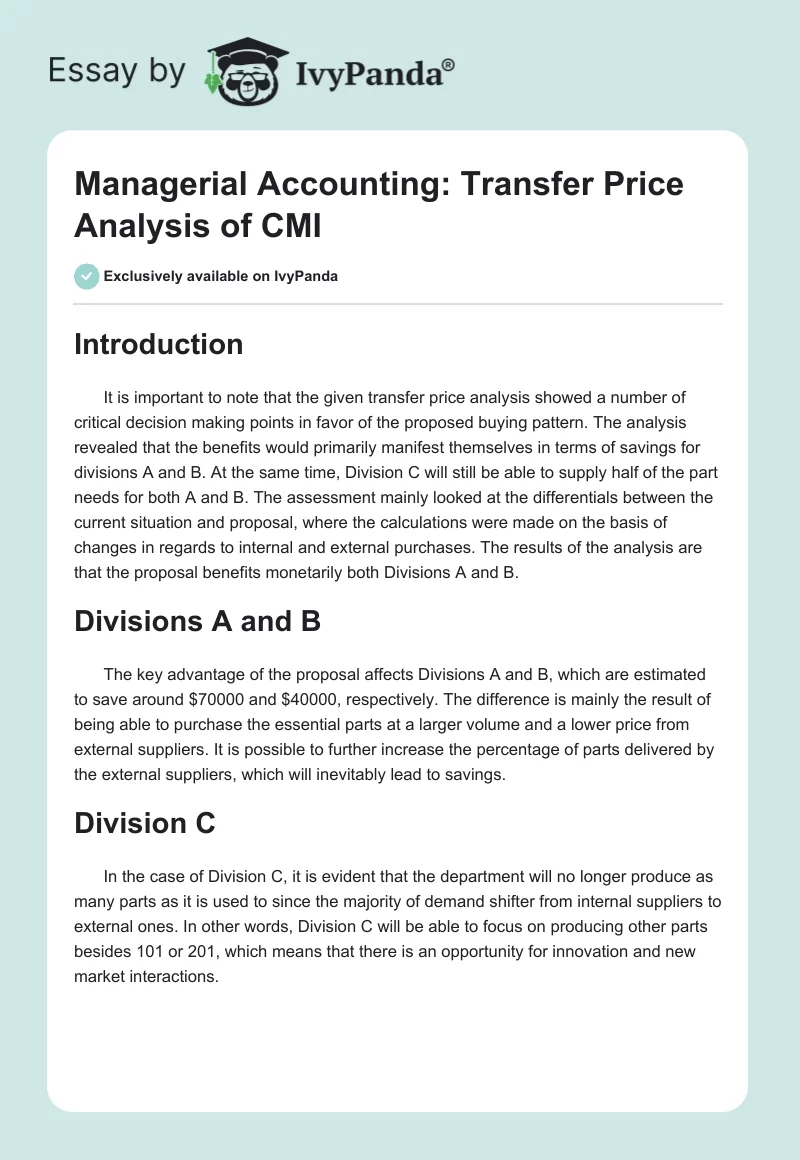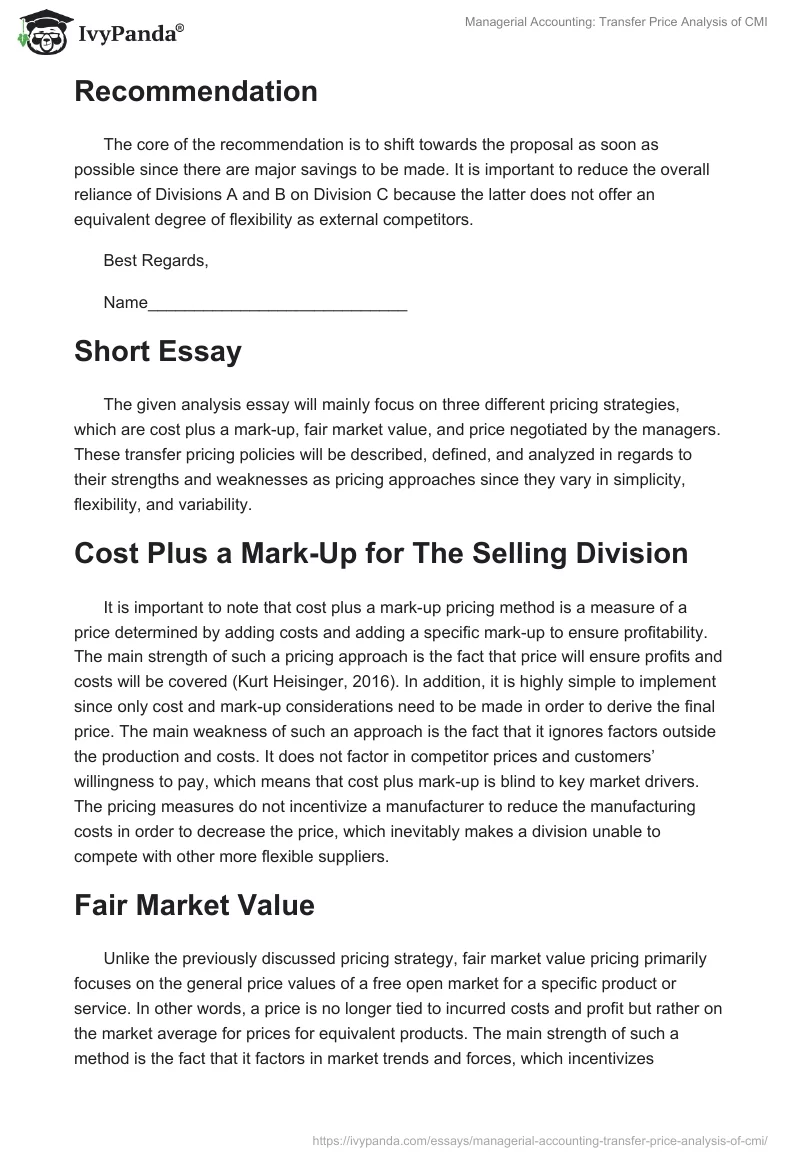Introduction
It is important to note that the given transfer price analysis showed a number of critical decision making points in favor of the proposed buying pattern. The analysis revealed that the benefits would primarily manifest themselves in terms of savings for divisions A and B. At the same time, Division C will still be able to supply half of the part needs for both A and B. The assessment mainly looked at the differentials between the current situation and proposal, where the calculations were made on the basis of changes in regards to internal and external purchases. The results of the analysis are that the proposal benefits monetarily both Divisions A and B.
Divisions A and B
The key advantage of the proposal affects Divisions A and B, which are estimated to save around $70000 and $40000, respectively. The difference is mainly the result of being able to purchase the essential parts at a larger volume and a lower price from external suppliers. It is possible to further increase the percentage of parts delivered by the external suppliers, which will inevitably lead to savings.
Division C
In the case of Division C, it is evident that the department will no longer produce as many parts as it is used to since the majority of demand shifter from internal suppliers to external ones. In other words, Division C will be able to focus on producing other parts besides 101 or 201, which means that there is an opportunity for innovation and new market interactions.
Recommendation
The core of the recommendation is to shift towards the proposal as soon as possible since there are major savings to be made. It is important to reduce the overall reliance of Divisions A and B on Division C because the latter does not offer an equivalent degree of flexibility as external competitors.
Best Regards,
Name____________________________
Short Essay
The given analysis essay will mainly focus on three different pricing strategies, which are cost plus a mark-up, fair market value, and price negotiated by the managers. These transfer pricing policies will be described, defined, and analyzed in regards to their strengths and weaknesses as pricing approaches since they vary in simplicity, flexibility, and variability.
Cost Plus a Mark-Up for The Selling Division
It is important to note that cost plus a mark-up pricing method is a measure of a price determined by adding costs and adding a specific mark-up to ensure profitability. The main strength of such a pricing approach is the fact that price will ensure profits and costs will be covered (Kurt Heisinger, 2016). In addition, it is highly simple to implement since only cost and mark-up considerations need to be made in order to derive the final price. The main weakness of such an approach is the fact that it ignores factors outside the production and costs. It does not factor in competitor prices and customers’ willingness to pay, which means that cost plus mark-up is blind to key market drivers. The pricing measures do not incentivize a manufacturer to reduce the manufacturing costs in order to decrease the price, which inevitably makes a division unable to compete with other more flexible suppliers.
Fair Market Value
Unlike the previously discussed pricing strategy, fair market value pricing primarily focuses on the general price values of a free open market for a specific product or service. In other words, a price is no longer tied to incurred costs and profit but rather on the market average for prices for equivalent products. The main strength of such a method is the fact that it factors in market trends and forces, which incentivizes manufacturers to be more competitive with external suppliers. However, the main weakness is rooted in the notion of having a free and open market, and since the case revolves around both closed and open markets, it might be difficult to determine whether fair market value pricing is plausible.
Price Negotiated by The Managers
The price negotiated by the managers relies on cooperation and collaboration as well as compromise, which are fairly difficult to achieve when it comes to determining to price for the divisions. The key strength of such a method is the fact that both parties can achieve satisfactory outcomes, and it ensures that the entire company is mostly independent of external suppliers giving it more autonomy. However, the main weakness is manifested in the fact that such a measure heavily relies on cooperativeness and collaboration, which might not always be achievable. Therefore, being unable to reach a point of agreement can result in more disruptions and resource consuming negotiations.
Pricing from Financial and Managerial Perspective
Transfer pricing is a significant issue from both managerial and financial perspectives because these two areas are interested in either profit or operational efficiency. In the case of financial management, being able to manufacture products are lower costs can mean that there are more profits. In regards to managerial aspects of pricing, it can lead to efficient growth of the manufacturing procedures by providing incentives or set up a stagnant production facility with no incentive for improvement. For example, cost plus a mark-up pricing might be plausible from a financial perspective, but it is a poor choice from a managerial one.
Conclusion
In conclusion, it is important to note that the proposal offers valid and sound direction for future decision making processes since all three pricing measures offer both strengths and weaknesses. Cost plus mark-up ensures profitability but does not factor in market forces, whereas fair market value makes a price competitive but can be flawed if the market of interest is not open and free. Lastly, the negotiated prices can be highly useful for both parties, but the lack of compromise and cooperativeness can hinder the decision making.
Reference
Kurt Heisinger. (2016). Managerial accounting 11.8: Transfer pricing between divisions[Video]. YouTube. Web.


